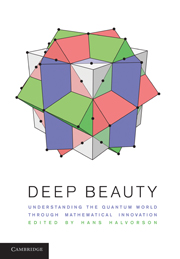Book contents
- Frontmatter
- Contents
- Contributors
- Preface
- Acknowledgments
- Introduction
- I Beyond the Hilbert Space Formalism: Category Theory
- II Beyond the Hilbert Space Formalism: Operator Algebras
- 7 Yet More Ado about Nothing: The Remarkable Relativistic Vacuum State
- 8 Einstein Meets von Neumann: Locality and Operational Independence in Algebraic Quantum Field Theory
- III Behind the Hilbert Space Formalism
- Index
8 - Einstein Meets von Neumann: Locality and Operational Independence in Algebraic Quantum Field Theory
from II - Beyond the Hilbert Space Formalism: Operator Algebras
Published online by Cambridge University Press: 01 June 2011
- Frontmatter
- Contents
- Contributors
- Preface
- Acknowledgments
- Introduction
- I Beyond the Hilbert Space Formalism: Category Theory
- II Beyond the Hilbert Space Formalism: Operator Algebras
- 7 Yet More Ado about Nothing: The Remarkable Relativistic Vacuum State
- 8 Einstein Meets von Neumann: Locality and Operational Independence in Algebraic Quantum Field Theory
- III Behind the Hilbert Space Formalism
- Index
Summary
Main Claim
I argue in this chapter that Einstein and von Neumann meet in algebraic relativistic quantum field theory in the following metaphorical sense: algebraic quantum field theory was created in the late 1950s/early 1960s and was based on the theory of “rings of operators,” which von Neumann established in 1935–1940 (partly in collaboration with J. Murray). In the years 1936–1949, Einstein criticized standard, nonrelativistic quantum mechanics, arguing that it does not satisfy certain criteria that he regarded as necessary for any theory to be compatible with a field theoretical paradigm. I claim that algebraic quantum field theory (AQFT) does satisfy those criteria and hence that AQFT can be viewed as a theory in which the mathematical machinery created by von Neumann made it possible to express in a mathematically explicit manner the physical intuition about field theory formulated by Einstein.
The argument in favor of this claim has two components:
1. Historical: An interpretation of Einstein's (semi)formal wordings of his critique of nonrelativistic quantum mechanics.
This interpretation results in mathematically explicit operational independence definitions, which, I claim, express independence properties of systems that are localized in causally disjoint spacetime regions. Einstein regarded these as necessary for a theory to comply with field theoretical principles.
2. Systematic: The presentation of several propositions formulated in terms of AQFT that state that the operational independence conditions in question do in fact typically hold in AQFT.
- Type
- Chapter
- Information
- Deep BeautyUnderstanding the Quantum World through Mathematical Innovation, pp. 343 - 362Publisher: Cambridge University PressPrint publication year: 2011
- 1
- Cited by



